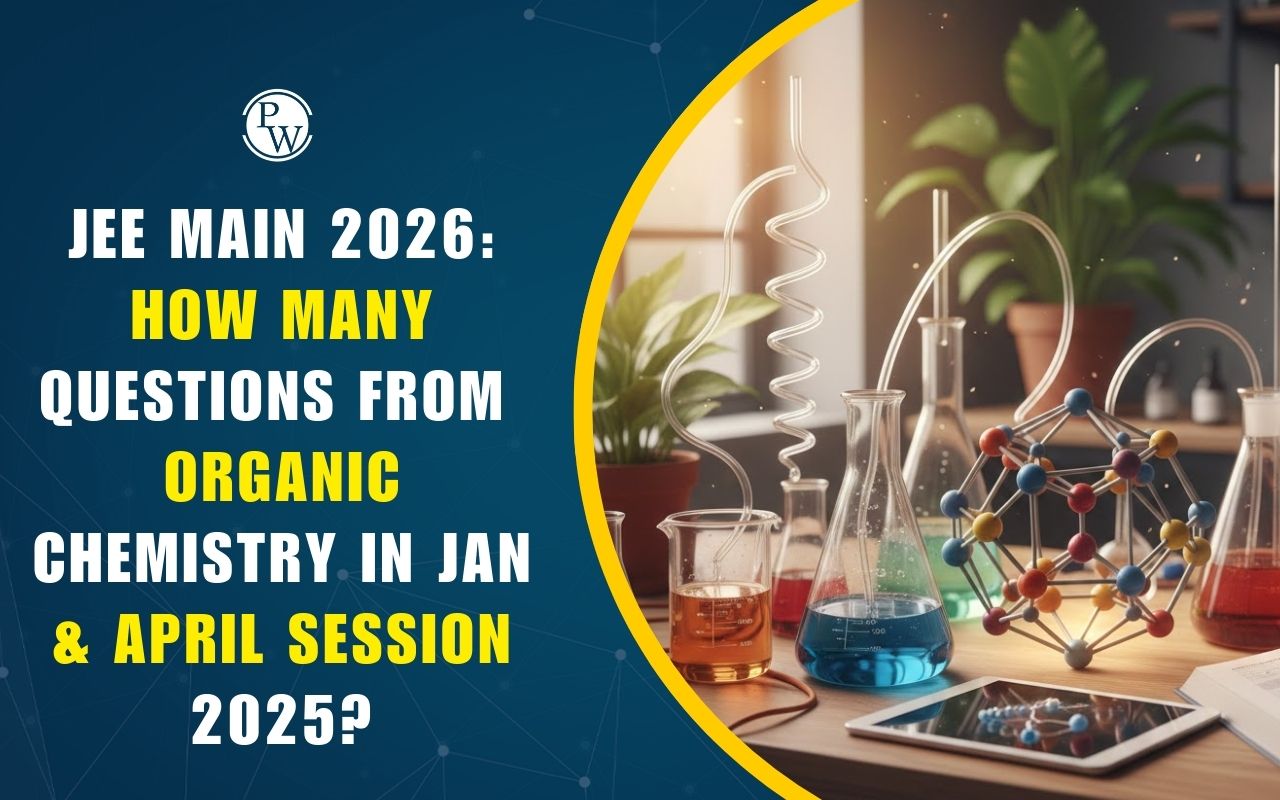
JEE Main Organic Chemistry Weightage 2025 : JEE Main Syllabus 2025 is expected to be released soon on the official website of NTA. There are three sections in JEE Main Chemistry Syllabus 2025 i.e., Section A Physical Chemistry, Section B Inorganic Chemistry, and Section C Organic Chemistry. Candidates should be aware of the chapter-wise JEE Main Organic Chemistry Weightage 2025 to prepare accordingly.
JEE Main Organic Chemistry Syllabus 2025 includes Purification and Characterization of Organic Compounds, Some Basic Principles of Organic Chemistry, Hydrocarbons, Organic Compounds containing Halogens, Organic Compounds containing Oxygen, Organic Compounds Containing Nitrogen, Polymers, Biomolecules, Chemistry in Everyday Life, and Principles Related to Practical Chemistry. Candidates can check topic-wise JEE Main Organic Chemistry Weightage 2025 in this article.JEE Main Organic Chemistry Weightage 2025
JEE Main Organic Chemistry includes various topics such as Purification and Characterization of Organic Compounds, Some Basic Principles of Organic Chemistry, Hydrocarbons, Organic Compounds containing Halogens, Organic Compounds containing Oxygen, etc. Candidates can check the unit-wise weightage in the table below.| JEE Main Organic Chemistry Weightage 2025 | |
| Unit | Weightage |
| Purification and Characterization of Organic Compounds | 0-1 |
| Some Basic Principles of Organic Chemistry | 1-2 |
| Hydrocarbons | 1-2 |
| Organic Compounds containing Halogens | 0-1 |
| Organic Compounds containing Oxygen | 0-1 |
| Organic Compounds Containing Nitrogen | 0-1 |
| Polymers | 0-1 |
| Biomolecules | 1 |
| Chemistry in Everyday Life | 0-1 |
| Principles Related to Practical Chemistry | 0-1 |
JEE Main Organic Chemistry Syllabus 2025
There are three sections in JEE Main Chemistry Syllabus 2025 Physical Chemistry, Inorganic Chemistry, and Organic Chemistry. Candidates can check the unit-wise included topics in JEE Main Organic Chemistry Syllabus 2025 in the table below.| JEE Main Organic Chemistry Syllabus 2025 | |
| Units | Topics |
| Purification and Characterization of Organic Compounds | Purification-Crystallization, sublimation, distillation, differential extraction and chromatography-principles and their applications. Qualitative analysis-Detection of nitrogen, sulphur, phosphorus and halogens. Quantitative analysis (basic principles only) – Estimation of carbon, hydrogen, nitrogen, halogens, sulphur, phosphorus. Calculations of empirical formulae and molecular formulae: Numerical problems in organic quantitative analysis, |
| Some Basic Principles of Organic Chemistry | Tetravalency of carbon: Shapes of simple molecules – hybridization (s and p): Classification of organic compounds based on functional groups: and those containing halogens, oxygen, nitrogen and sulphur; Homologous series: Isomerism – structural and stereoisomerism. Nomenclature (Trivial and IUPAC) Covalent bond fission – Homolytic and heterolytic: free radicals, carbocations and carbanions; stability of carbocations and free radicals, electrophiles and nucleophiles. Electronic displacement in a covalent bond – Inductive effect, electromeric effect, resonance and hyperconjugation. Common types of organic reactions Substitution, addition, elimination and rearrangement. |
| Hydrocarbons | Classification, isomerism, IUPAC nomenclature, general methods of preparation, properties and reactions. Alkanes: Conformations: Sawhorse and Newman projections (of ethane): Mechanism of halogenation of alkanes. Alkenes: Geometrical isomerism: Mechanism of electrophilic addition: addition of hydrogen, halogens, water, hydrogen halides (Markownikoffs and peroxide effect): Ozonolysis and polymerization. Alkynes: Acidic character: Addition of hydrogen, halogens, water and hydrogen halides: Polymerization. Aromatic hydrocarbons: Nomenclature, benzene – structure and aromaticity: Mechanism of electrophilic substitution: halogenation, nitration. Friedel – Craft’s alkylation and acylation, directive influence of the functional group in mono-substituted benzene. |
| Organic Compounds containing Halogens | General methods of preparation, properties and reactions; Nature of C-X bond; Mechanisms of substitution reactions. Uses; Environmental effects of chloroform, iodoform freons and DDT. |
| Organic Compounds containing Oxygen | General methods of preparation, properties, reactions and uses. ALCOHOLS, PHENOLS AND ETHERS Alcohols: Identification of primary, secondary and tertiary alcohols: mechanism of dehydration. Phenols: Acidic nature, electrophilic substitution reactions: halogenation. nitration and sulphonation. Reimer – Tiemann reaction. Ethers: Structure. Aldehyde and Ketones: Nature of carbonyl group; Nucleophilic addition to >C=O group, relative reactivities of aldehydes and ketones; Important reactions such as – Nucleophilic addition reactions (addition of HCN. NH3, and its derivatives), Grignard reagent; oxidation: reduction (Wolf Kishner and Clemmensen); the acidity of -hydrogen. aldol condensation, Cannizzaro reaction. Haloform reaction, Chemical tests to distinguish between aldehydes and Ketones. Carboxylic Acids Acidic strength and factors affecting it |
| Organic Compounds containing Nitrogen | General methods of preparation. Properties, reactions and uses. Amines: Nomenclature, classification structure, basic character and identification of primary, secondary and tertiary amines and their basic character. Diazonium Salts: Importance in synthetic organic chemistry. |
| Polymers | General introduction and classification of polymers, general methods of polymerization, – Addition and condensation, copolymerization. Natural and synthetic, rubber and vulcanization, some important polymers with emphasis on their monomers and uses – polythene, nylon, polyester and bakelite. |
| Biomolecules | General introduction and classification of polymers, general methods of polymerization, – Addition and condensation, copolymerization. Natural and synthetic, rubber and vulcanization, some important polymers with emphasis on their monomers and uses – polythene, nylon, polyester and bakelite. PROTEINS: Elementary Idea of -amino acids, peptide bond, polypeptides. Proteins: primary, secondary, tertiary and quaternary structure (qualitative idea only), denaturation of proteins, enzymes. VITAMINS: Classification and functions. Nucleic Acids: Chemical constitution of DNA and RNA. Biological functions of nucleic acids. |
| Chemistry in Everyday Life | Chemicals in Medicines – Analgesics, tranquillizers, antiseptics, disinfectants, antimicrobials, anti-fertility drugs, antibiotics, antacids. Anti-histamines – their meaning and common examples. Chemicals in food – Preservatives, artificial sweetening agents – common examples. Cleansing Agents – Soaps and detergents, cleansing action |
| Principles Related to Practical Chemistry | Detection of extra elements (Nitrogen, Sulphur, halogens) in organic compounds; Detection of the following functional groups; hydroxyl (alcoholic and phenolic), carbonyl (aldehyde and ketones) carboxyl and amino groups in organic compounds. The chemistry involved in the preparation of the following: Inorganic compounds; Mohr’s salt, potash alum. Organic compounds: Acetanilide, p-nitro acetanilide, aniline yellow, iodoform. The chemistry involved in the titrimetric exercises – Acids, bases and the use of indicators, oxalic-acid vs KMnO4, Mohr’s salt vs KMnO4 Chemical principles involved in the qualitative salt analysts: Cations – Pb2+, Cu2+, Al3+, Fe3+, Zn2+, Ni2+ , Ca2+, Ba2+, Mg2+ , NH4 + Anions- CO3 2−, S 2- ,SO4 2−, NO3- , NO2- , Cl- , Br- , I- ( Insoluble salts excluded). Chemical principles involved in the following experiments: 1. Enthalpy of solution of CuSO4 2. Enthalpy of neutralization of strong acid and strong base. 3. Preparation of lyophilic and lyophobic sols. 4. Kinetic study of the reaction of iodide ion with hydrog |
JEE Main Organic Chemistry Preparation Tips 2025
Candidates preparing for JEE Main 2025 exam can follow the below tips to secure good marks in JEE Main Organic Chemistry section.- Understand the Basics: Understand basic concepts like hybridization, types of reactions, and mechanisms. These are very important for solving more complex problems.
- Learn Reactions and Mechanisms: Focus on key reactions (like substitution and elimination) and how they work. Practice mechanisms to see how different reagents and conditions affect reactions.
- Go through the Functional Groups: Get familiar with different functional groups (like alcohols, aldehydes, and ketones) and their properties. This helps in identifying and predicting reactions.
- Practice Synthesis: Work on synthesis problems where you create compounds from given reactants. This helps in understanding how different reactions are used in real life.
- Use NCERT Books : Refer to NCERT textbooks for clear explanations and practice questions. NCERT books cover the whole syllabus comprehensively and are great for building the basics.
- Solve Previous Papers: Practice with previous years’ JEE Main papers to know the type of questions asked in the exam and to improve your problem-solving skill.
Best Study Materials For JEE Main Organic Chemistry Syllabus 2025
Candidates can check the below study materials prepared by the experienced faculties of Physics Wallah for JEE Main 2025 Chemistry subject.JEE Main Organic Chemistry Weightage 2025 FAQs
Q.1 : What are the topics included in JEE Main Organic Chemistry Syllabus?
Ans. JEE Main Organic Chemistry Syllabus 2025 includes Purification and Characterization of Organic Compounds, Some Basic Principles of Organic Chemistry, Hydrocarbons, Organic Compounds containing Halogens, Organic Compounds containing Oxygen, Organic Compounds Containing Nitrogen, Polymers, Biomolecules, Chemistry in Everyday Life, and Principles Related to Practical Chemistry.
Q.2 : Which chapter has the highest weightage in JEE Main Organic Chemistry 2025?
Ans. Hydrocarbons has the highest weightage in JEE Main Organic Chemistry 2025. Candidates can expect 2 questions from this chapter.
Q.3 : Which is the best book for JEE Main 2025 Preparation?
Ans. Candidates must refer to the NCERT books for JEE Main 2025 preparation. Students can also refer to the study materials by Physics Wallah to score good marks in JEE Main 2025.
Q.4 : How many questions are expected from JEE Main Organic Chemistry Syllabus 2025?
Ans. Candidates can expect 5-6 questions from JEE Main Organic Chemistry Syllabus 2025.
Talk to a counsellorHave doubts? Our support team will be happy to assist you!

Free Learning Resources
PW Books
Notes (Class 10-12)
PW Study Materials
Notes (Class 6-9)
Ncert Solutions
Govt Exams
Class 6th to 12th Online Courses
Govt Job Exams Courses
UPSC Coaching
Defence Exam Coaching
Gate Exam Coaching
Other Exams
Know about Physics Wallah
Physics Wallah is an Indian edtech platform that provides accessible & comprehensive learning experiences to students from Class 6th to postgraduate level. We also provide extensive NCERT solutions, sample paper, NEET, JEE Mains, BITSAT previous year papers & more such resources to students. Physics Wallah also caters to over 3.5 million registered students and over 78 lakh+ Youtube subscribers with 4.8 rating on its app.
We Stand Out because
We provide students with intensive courses with India’s qualified & experienced faculties & mentors. PW strives to make the learning experience comprehensive and accessible for students of all sections of society. We believe in empowering every single student who couldn't dream of a good career in engineering and medical field earlier.
Our Key Focus Areas
Physics Wallah's main focus is to make the learning experience as economical as possible for all students. With our affordable courses like Lakshya, Udaan and Arjuna and many others, we have been able to provide a platform for lakhs of aspirants. From providing Chemistry, Maths, Physics formula to giving e-books of eminent authors like RD Sharma, RS Aggarwal and Lakhmir Singh, PW focuses on every single student's need for preparation.
What Makes Us Different
Physics Wallah strives to develop a comprehensive pedagogical structure for students, where they get a state-of-the-art learning experience with study material and resources. Apart from catering students preparing for JEE Mains and NEET, PW also provides study material for each state board like Uttar Pradesh, Bihar, and others
Copyright © 2025 Physicswallah Limited All rights reserved.
Get App









